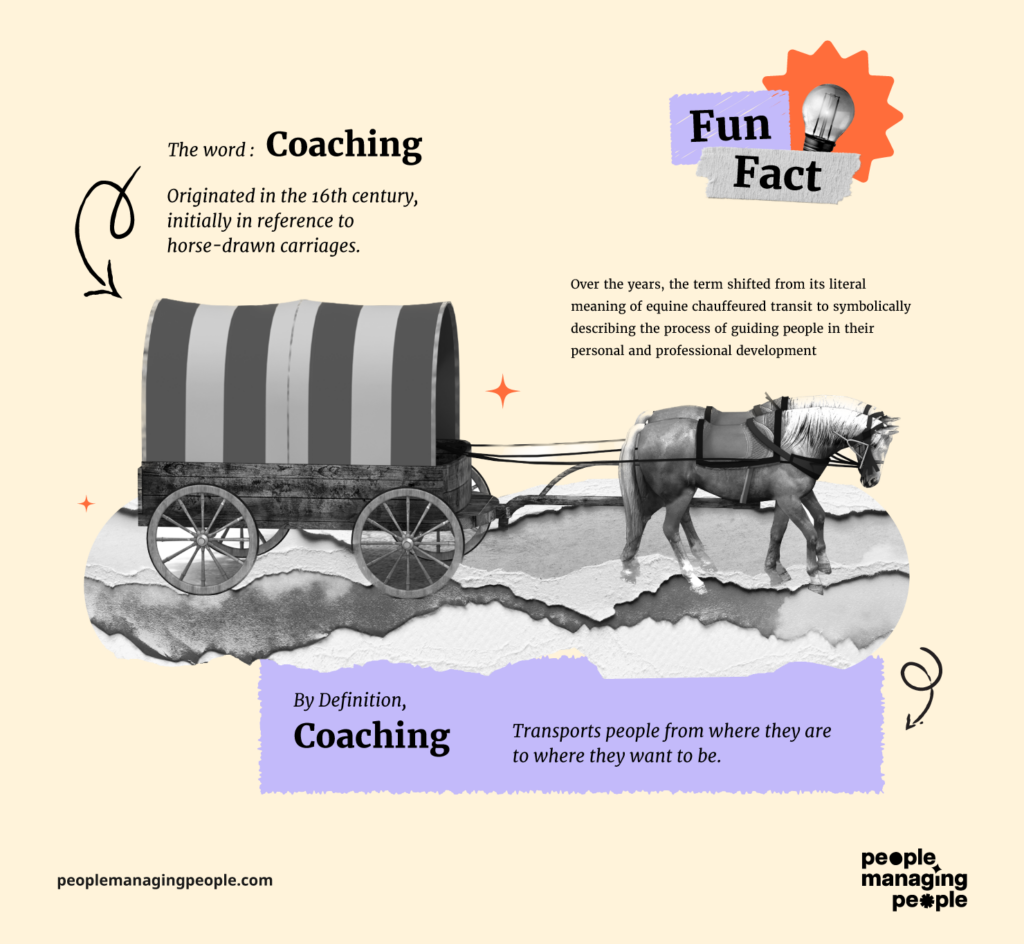A coaching culture is one where coaching practices are embedded in daily interactions and management strategies, promoting continuous learning, development, and personal growth.
There’s a ton of evidence that demonstrates that a workplace culture that embraces a coaching mindset is better equipped to meet organizational goals.
However, as human resources leaders, this isn’t an initiative we can “drive” within our organizations.
Rather, it's an effort that we’ll need to help grow and nurture because success means participation and ownership from everyone.
Here I'll take you through what a coaching culture means and how to nurture it in your org.
What Is A Coaching Culture?
In an organization with a coaching culture, coaching behaviors are blended into its DNA.
It's an environment where everyone—from the C-suite to brand new hires—learns, adopts, and genuinely practices coaching techniques in their daily interactions.
Forbes describes coaching culture as “One where every employee, regardless of their level, is empowered to learn, grow and develop to their fullest potential and feels supported by their leaders.”

Benefits Of A Coaching Culture
The reasons to arm your team members with coaching skills are undeniably compelling.
Organizations with strong coaching cultures report:
- Employees feel appreciated for their unique contributions
- Continuous feedback flows readily
- Commitments are made and kept
- Difficult conversations are routine
- A growth mindset is embraced company-wide.
There are measurable benefits as well:
- Identifying and developing high-performers
- Up leveling of skills and career growth
- Greater employee engagement
- Improved employee retention
- Increased revenue and profitability.
Coaching culture case studies
A recent Fortune article tells the story of a company that replaced all of its managers with coaches and the impact it had on worker happiness and productivity.
Microsoft created a coaching initiative for its leaders where they actively practice a growth mindset by focusing on role modeling, coaching their employees to be role models, and showing they care about their employees and their personal development.
There’s also an interesting case study from TD Bank that shows how coaching significantly contributed to positive wins for the company, including record-breaking customer experience scores and increased employee engagement and retention.
I’ve also seen the benefits firsthand.
At a previous organization, our sales team was faced with the challenge of learning more complex new products.
We brought in external coaches who helped the team identify potential barriers to development, recognize their skills and knowledge gaps, and embrace vulnerability and a growth mindset.
The outcome was better than expected. Not only did the team gain confidence and grow their business acumen, they also became more empowered by their leaders to manage their territories and books of businesses more autonomously.
They also developed regular opportunities for knowledge sharing amongst the team and used coaching questions at the end of each team meeting, round table style, to keep engagement and open communication as important pillars of their new way of operating.
5 Steps To Establish A Coaching Culture
So now you’re intrigued (or at least curious, which is notably coach-like of you!) but not sure where to go from here.
Let’s start by taking a look at some steps to help get you started.
1) Define the goal
Begin by identifying the specific goal or desired outcome your organization will gain from embracing a coaching culture.
Are you looking to improve team productivity and collaboration? Boost sales performance? Reduce burnout? Develop leaders?
Identify key current and specific organizational goals and challenges and determine how a coaching culture will offer solutions.
Getting clear here will pave the path for the next steps.
2) Get leadership support and buy-in
You’re going to need buy-in and support from leadership, just as you would for any transformative endeavor.
Present clear benefits
Use relevant data and research to highlight the benefits of adopting a coaching-centric culture.
Share specific case studies and examples of similar organizations that have successfully integrated a coaching culture, and emphasize its critical role in maintaining a competitive edge in the market.
This is also a great opportunity to incorporate the employee voice by using your organization’s employee survey data to show the desire for coaching, and by collecting feedback from employees who have experienced the benefits of coaching themselves.
Showcase the ROI
Demonstrate how coaching can lead to the specific outcomes you identified in your goal, and show how these returns lead to enhanced financial outcomes.
Dip your toes in the water first
Consider launching a coaching program in a select team or department as a trial run. As you gather insights from this pilot phase, you’ll be able to lay out its positive results for your leaders and highlight the tangible benefits it brings to the table.
Provide firsthand experience
Perhaps one of the most impactful ways to demonstrate the benefits is to provide the opportunity for leaders to go through the coaching experience themselves.
Consider executive coaching for your senior leaders with an emphasis on both professional and personal development.
3) Choose the coaching model and approach
Following leadership buy-in, it’s time to choose which coaching model will work best for your organization.
This will be the structured and consistent framework used by leaders to help guide them through the coaching process and will provide common language and context for both the coaches (leaders) and coachees (employees) to work within.
Research a few different coaching models and consider the applicability and relevance of each model to your organization, its values, and desired outcomes. Evaluate how easily the model can be woven into current practices.
The chosen model should be flexible enough to meet the diverse coaching needs across all employee levels, and also be scalable to grow with your organization.
A really simple and widely used model is the GROW model. It's a 4-step model designed to address goal setting and problem-solving by asking the following questions:
(G)oal—what are you looking to achieve?
(R)reality—what is the current situation?
(O)options—how would you tackle this if time wasn’t a factor?
(W)ill—what will you do now?
Lastly, you’ll need to determine what the training needs will be relative to the specific model you’ve chosen.
Will you just be training your leaders on how to have coaching conversations, or will hiring and training internal coaches also be part of the plan?
Maybe a blended approach makes sense, where your leaders manage coaching in the day-to-day and professional coaches are utilized situationally.
Whatever approach you take, you’ll want to make sure that everyone is trained and using the model consistently.
4) Integrate coaching into the day to day
Integrating coaching into daily operations is all about continuous learning, open communication, and empowerment.
Embed coaching into conversations
Regular one-on-one discussions are a great time for coaching conversations.
Instead of managers giving directives, they should come with curiosity and create a dialogue by asking their team members open-ended questions that encourage reflection and insight.
A fantastic resource to help with this is the book The Coaching Habit by Michael Bungay Stanier, and specifically the 7 questions the book is based around.
- The Kickstart Question: “What’s on your mind?”
- The AWE Question: “And what else?”
- The Focus Question: “What’s the real challenge here for you?”
- The Foundation Question: “What do you want?”
- The Lazy Question: “How can I help?”
- The Strategic Question: “If you’re saying Yes to this, what are you saying No to?”
- The Learning Question: “What was most useful for you?”
Embrace a growth mindset
This is the idea that our talents aren’t just fixed qualities, rather they can develop and refine with continuous learning and there’s always room for improvement.
The advantage of this kind of thinking is that it leads to improved problem-solving, innovation, and calculated risk-taking—viewing challenges and failures as opportunities for growth.
Empower decision making
This starts with psychological safety. An ideal environment encourages people to share ideas, ask questions, bring up concerns, take risks, and admit mistakes—all without the fear of negative consequences.
From there, delegating authority, granting more access to tools and data, providing guidance and support, and employee recognition help set people up to make decisions with confidence.
Establish a feedback culture
This requires trust, significant effort, and commitment to get it right. Because of that, consider investing in training that teaches employees how to constructively give and receive feedback.
This will help establish clear guidelines and expectations on how feedback is expected to be given and received in your organization, which will help to prevent misunderstandings and misinterpretations.
Feedback should happen regularly and in real-time (when possible) so that it's fresh and actionable while still top of mind.
5) Measure and analyze impact
To understand how effective your efforts are in building a coaching culture, you’ll want to measure its impact.
For quantitative metrics, pre and post-coaching surveys are a great idea to measure changes in participants' behaviors, attitudes, and skills.
If one of the goals of a coaching culture was to enhance performance, measuring KPIs before and after would be a metric to note. Maybe reducing turnover was top of mind, so comparing employee retention rates before and after implementing coaching would be important data points for your analysis.
Looking at qualitative metrics and anecdotal data is helpful too! Consider gathering feedback from team members to understand their personal experiences, breakthroughs, and challenges as a result of the coaching experience.
Soliciting feedback from peers and their managers can also help shine a light on how the impact of coaching shows up in the coachee’s day to day and can identify areas to hone in on and develop.
Challenges Of Implementing A Coaching Culture
It's a good idea to be aware of potential challenges that might delay or prevent a coaching culture.
Cultural misalignment
A coaching culture needs to align with your overall organizational culture.
For example, if you have a hierarchical culture where there is a strict structure in place and decisions are made from the top down, introducing mindset shifts towards more collaboration and empowerment can take time.
Unclear objectives
Coaching goals and expected outcomes should align with the overall objectives of the business. If these objectives are not closely tied, coaching efforts can feel directionless and may miss the mark on what you are trying to achieve.
Resistance to change
If your organization is comfortable with its current culture and structure, leadership (and employees) might be resistant to adopting new approaches and practices that disrupt their typical way of working together.
This is a situation where making changes slowly and celebrating the small wins can go a long way.
A Coaching Culture Will Help Move Your Organization Forward
Embracing a coaching culture is a transformative journey that touches every aspect of the business from the top down.
A coaching environment cultivates more engaged, resilient, and future-ready talent that’s more aligned with organizational growth and success.
Remember, at its core, coaching is about guiding individuals on their personal and professional journeys, ensuring they reach their desired destinations.
By adopting a coaching culture, your organization is not just keeping up with (and surpassing!) the competition but is setting the stage for limitless growth and evolution.
Join The People Manging People Community
For further guidance on implementing a coaching culture in your organization, join our supportive community of HR and business leaders sharing knowledge to help you progress in your career and make greater impact in your org.


